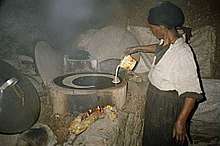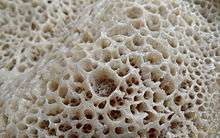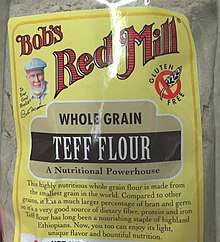Injera
Injera, ənǧära እንጀራ [ɨndʒəra], (Oromo: Biddeena) is a sour fermented flatbread with a slightly spongy texture, traditionally made out of teff flour. It is the national dish of Ethiopia, Eritrea, Djibouti and Somalia.[2][1] [3] It is central to the dining process in those cultures as bread is the most fundamental component.[4][5][1]
 Meal consisting of injera and several kinds of wat or tsebhi (stew) or (maraq), typical of Ethiopian and Eritrean, Somali | |
| Alternative names | Tajta, Biddeena, Canjeero, Canjeelo, Laxox |
|---|---|
| Type | Flatbread |
| Place of origin | Eritrea, Somalia, Ethiopia, Djibouti,[1][2] |
| Region or state | Ethiopia, Eritrea, Somalia, Djibouti |
| Main ingredients | Teff flour (or sometimes wheat, barley, millet, corn, or rice flour) |
| Variations | Canjeero, Canjeelo, Laxox, |
Preparation
Injera is usually made from tiny, iron-rich teff seeds, which are ground into flour. Teff production is limited to certain middle elevations with adequate rainfall, and, as it is a low-yield crop,[6] it is relatively expensive for the average household. As many farmers in the Ethiopian highlands grow their own subsistence grains, wheat, barley, corn, or rice flour are sometimes used to replace some or all of the teff content. Teff seeds are graded according to color, used to make different kinds of injera: nech (white), key or quey (red), and sergegna (mixed).[6] Teff flour is gluten-free.

To make injera, teff flour is mixed with water. The fermentation process is triggered by adding ersho, a clear, yellow liquid that accumulates on the surface of fermenting teff flour batter and is collected from previous fermentations. Ersho contains (aerobic) Bacillus species and several yeasts (in order of abundance): Candida milleri, Rhodotorula mucilaginosa, Kluyveromyces marxianus, Pichia naganishii and Debaromyces hansenii.[7] [6] The mixture is then allowed to ferment for an average of two to three days, giving it a mildly sour taste. The injera is baked into large, flat pancakes. The dough's viscosity allows it to be poured onto the baking surface, rather than rolled out, which is unusual for a yeast or sourdough bread.
In terms of shape, injera compares to the French crêpe and the Indian dosa as a flatbread cooked in a circle and used as a base for other foods. In taste and texture, it is more similar to the South Indian appam. The bottom surface of the injera, which touches the heating surface, has a relatively smooth texture, while the top is porous. This porous texture makes injera good for scooping up sauces and dishes.
Ingredients
Traditionally, injera is made with just two ingredients – Eragrostis tef, also known as teff, an ancient grain from the highlands of Ethiopia,[8] and water. There is little written or known about teff's origin[9] and while there is no scholarly consensus, some believe that the production of teff dates back as far as 4000 BC.[10][11] When teff is not available, usually because of location or financial limitations, injera is made by fermenting a variety of different grains, including barley, millet, and sorghum.[10] Teff is, however, the preferred grain for making injera, primarily because of its sensory attributes (color, smell, taste).[6]
A variant of injera known as canjeelo is prepared from a dough of plain flour, self-raising flour, warm water, yeast, and salt. The mixture is beaten by hand until soft and creamy.[12] Sorghum is the preferred flour for making canjeelo. There is a sweet-tasting version, and malawah, a variety made with eggs .[13]
Cooking method
The cooking method for injera has changed little since its origin. Traditionally, the flour is mixed with water and fermented. It is baked by pouring the mixture onto a large circular griddle, known as a mitad.
Baking surface
Baking is done on a circular griddle - either a large black clay plate over a fire or a specialized electric stove. The griddle is known as a mitad (ምጣድ) (in Amharic) or mogogo (ሞጎጎ) (in Tigrinya). Mitads have been found at archaeological sites dating back as far as 600 AD.[10] Nowadays, mitads are no longer always made out of clay, but can also be electric.
Traditional clay stoves can be inefficient in that they consume large amounts of firewood and produce a lot of smoke, creating household pollution and making them dangerous to use around children.[14] In 2003, an Eritrean research group designed a stove for cooking injera and other foods that uses more easily available fuel, such as twigs instead of large branches, crop residues and dung, locally called kubet.[15] Several parts of this new stove are made in the central cities of Ethiopia and Eritrea, while other parts are moulded from clay by women in local areas.[15]
Many women in urban areas—especially those living outside Ethiopia and Eritrea—now use electric injera stoves, which are topped with a large metal plate, or simply non-stick frying pans.
Consumption and contemporary use

In Ethiopia and Eritrea, a variety of stews, salads (during Ethiopian Orthodox fasting, for which believers abstain from most animal products), and more injera (called injera firfir) are placed on the injera for serving. Using one's hand (traditionally only the right one),[16][17] small pieces of injera are torn and used to grasp the stews and salads for eating. The injera under these stews soaks up the juices and flavors of the foods, and after the stews and salads are gone, this bread is also consumed. Injera is thus simultaneously a food, eating utensil, and plate. When the entire "tablecloth" of injera is gone, the meal is over.
In Ethiopia, Eritrea and Somalia injera is eaten daily in virtually every household. Outside the Horn of Africa and Israel, injera may be found in grocery stores and restaurants specializing in Ethiopian, Eritrean and Somali cooking. While originally specific to Ethiopia and other parts of the Horn of Africa, the Beta Israel, Jews originating in Ethiopia and Eritrea who now mainly live in Israel, have spread injera to that country.
Injera is the most important component of any Ethiopian meal. It is often both the serving platter and utensil for a meal. Hearty stews such as wat are placed on top of the bread and then the meal is eaten by tearing pieces of injera off and scooping up the stews.[10][18] While injera's literal use as the base and staple of any Ethiopian meal has not changed since its creation, its symbolic value has changed. Different varieties of injera can be found in the highlands versus the lowlands of Ethiopia. In the lowlands, injera is often made with sorghum and in the highlands it is more commonly made with barley.[4] Either way, because it is made with something other than teff, its symbolic value has already decreased compared to the symbolic value of injera made with teff. There are symbolic value differences with types of teff as well. White-grained teff is more expensive to buy and thus symbolizes a higher status than its cheaper counterpart, red-grained teff.[4]
Variations
There are similar variants to injera in other East African countries like Djibouti, Somalia and Sudan. Canjeero, canjeelo or laxox, the Somali and the Djiboutian version of injera, is a staple of Somali and Djiboutian cuisine.[19][20] The variant eaten in South Sudan, Sudan and Chad is known as kisra.[21] In Somalia, at breakfast (referred to as qurac), the main meal of the day, injera (known as canjeero) might also be eaten with a stew (maraq) or soup.[22]
Outside Ethiopia and Eritrea
United States

Injera became more common in the United States during a big spike in Ethiopian immigration in the 1980s and 1990s,[23] largely because of the Refugee Act passed in 1980.[24] Teff is now being produced in the United States by the Teff Company in Idaho, making teff more accessible to expatriate Ethiopians.[25]
See also
- List of Ethiopian dishes and foods
- Sudanese cuisine
- Baghrir
- List of African dishes
- Tava
- Comal
- Qatayef
- Trencher_(tableware)
References
- Clarkson, Janet (2013). Food History Almanac: Over 1,300 Years of World Culinary History, Culture, and Social Influence. Rowman & Littlefield Publishers. p. 1293. ISBN 978-1-4422-2715-6.
- Cauvain, Stanley P.; Young, Linda S. (2009). The ICC Handbook of Cereals, Flour, Dough & Product Testing: Methods and Applications. DEStech Publications, Inc. p. 216. ISBN 9781932078992.
Injera is the fermented pancake-like flatbread, which originated in Ethiopia and Eritrea.
- "Ethiopian Injera Recipe". Exploratorium. 4 October 2016. Retrieved 28 March 2017.
- Lyons, Diane; D' Andrea, A. Catherine (September 2003). "Griddles, Ovens, and Agricultural Origins: An Ethnoarchaeological Study of Bread Baking in Highland Ethiopia". American Anthropologist. 105 (3): 515–530. doi:10.1525/aa.2003.105.3.515. JSTOR 3566902.
- Mekonnen, Yohannes (29 January 2013). Ethiopia: the Land, Its People, History and Culture. Yohannes Mekonnen. p. 362. ISBN 978-1-4823-1117-4.
- Bart, Minten; Seyoum, Taffesse, Alemayehu; Petra, Brown (19 July 2018). The economics of teff: Exploring Ethiopia's biggest cash crop. Intl Food Policy Res Inst. ISBN 9780896292833.
- Ashenafi, M. (1994). "Microbial flora and some chemical properties of ersho, a starter for teff (Eragrostis tef) fermentation". World Journal of Microbiology & Biotechnology. 10: 69–73. doi:10.1007/BF00357567. PMID 24420890.
- Jones, Wilbert (2010). "A Taste of Ethiopian Cuisine". Computers & Applied Sciences Complete: 55–56.
- Ingram, Amanda L.; Doyle, Jeff J. (2003). "The Origin and Evolution of Eragrostis Tef (Poaceae) and Related Polyploids: Evidence From Nuclear waxy and Plastid rps16". American Journal of Botany. Ithaca, New York: Cornell University, L. H. Bailey Hortorium. 90 (1): 116–122. doi:10.3732/ajb.90.1.116. JSTOR 4122731. PMID 21659086.
- Kloman, Harry (2010). Mesob Across America: Ethiopian Food in the U.S.A. New York: IUniverse.
- Zanteson, Lori (2015). "It's Teff Time". Environmental Nutrition. 38 (11): 8.
- Steinberg, Liz (4 January 2009). "Saturday brunch: Lahoh, purple salad with ginger-dill dressing and more". Cafe Liz. Retrieved 11 August 2019.
- Abdullahi, Mohamed Diriye (2001). Culture and Customs of Somalia. Greenwood Publishing Group. p. 113. ISBN 978-0-313-31333-2.
- Diehl, Jan Carel; Jones, Robin; Verwaal, Martin (4 May 2017). "The Development of an Energy Efficient Electric Mitad for Baking Injeras in Ethiopia". 2017 International Conference on the Domestic Use of Energy (DUE). pp. 75–82. doi:10.23919/DUE.2017.7931827. ISBN 978-0-9946759-2-7.
- "Ashden awards: REC (formerly ERTC), Eritrea – Local construction of efficient stoves". Ashden. 2003. Retrieved 17 October 2017.
- Bhandari, Aparita (15 March 2017). "How to Eat: Ethiopian cuisine is hands-on". Toronto Star. Retrieved 29 March 2017.
- McManus, Chris (2004). Right Hand, Left Hand: The Origins of Asymmetry in Brains, Bodies, Atoms and Cultures. Harvard University Press. p. 24. ISBN 9780674016132.
Other Bantu languages mostly talked about the 'eating hand' and, [...]
- Sokolov, Raymond (1993). "The Teff Also Rises". Natural History. 102 (3): 96.
- Adriana Chirea (2 July 2012). "Somali Anjero (Canjeero)". vegan-magic.blogspot.com. Retrieved 28 March 2017.
- Cauvain, Stanley P.; Young, Linda S. (2007). Technology of Breadmaking. Springer. p. 225. ISBN 9780387385655.
- Burdett, Avani (2012). Delicatessen Cookbook – Burdett's Delicatessen Recipes: How to make and sell Continental & World Cuisine foods. Springwood emedia. ISBN 9781476144627.
- Abdullahi, Mohamed Diriye (2001), "5: Cuisine and Traditional Dress", Culture and customs of Somalia, Culture and Customs of Africa, Westport, CT: Greenwood, ISBN 9780313313332, ISSN 1530-8367,
Injera, known in the north as lahooh, is a thin pancake that is made from batter poured in a circular pattern starting in the center of a hot greased pan..... Sorghum is the preferred flour for making injera, which is common in the countries of the Horn.
- "Yearbook of Immigration Statistics 2008". Department of Homeland Security. 4 May 2016. ISSN 0743-538X. OCLC 7063193. Retrieved 11 August 2019.
- Chacko, Elizabeth (2003). "Identity and Assimilation among Young Ethiopian Immigrants in Metropolitan Washington". Geographical Review. American Geographical Society. 93 (4): 491–506. doi:10.1111/j.1931-0846.2003.tb00044.x. JSTOR 30033939.
- Weil, Josh (1 August 2007). "To Ethiopians in America, Bread is a Taste of Home". The New York Times. Retrieved 8 May 2018.
Further reading
- The Deep Dish on Chicago Ethiopian Companion website to Kloman's book: Mesob Across America
- Injera's Journey To Chicago The Red Fork, Chicago food blog entry
- Here, Eat This: A Beginner's Guide to Ethiopian Food A Houston Press article that outlines all the basics for Ethiopian cuisine
- Crang, Philip; Cook, Ian (1996). "The World on a Plate: Culinary Culture, Displacement and Geographical Knowledges". Journal of Material Culture. 1 (2): 131–156. doi:10.1177/135918359600100201.
- de Solier, Isabelle. Food and the Self: Consumption, Production, and Material Culture. Bloomsbury Academic. 2013
External links
| Wikibooks Cookbook has a recipe/module on |
- Mesob Across America: Ethiopian Food in the U.S.A. A book about the history and culture of Ethiopian cuisine
- Ethiopian Food: Mesob Across America A blog about Ethiopian food
- Ethiopian Restaurant Guide Includes video visits to some restaurants
- Ashden awards: Local construction of efficient stoves

